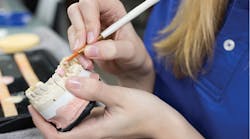Explaining the crown: After a root canal, the crown is often the best restorative choice
By Jannette Whisenhunt, RDH, BS, MEd, PhD
Last month, we started a series for new dental hygienists that focuses on explaining dental procedures to patients. We know so much about prevention, but it can sometimes feel awkward to explain restorative procedures if we are unfamiliar with them. This can be very intimidating, and these procedures can seem foreign to new hygienists who have not had the opportunity to watch them being performed.
Last month's column discussed explaining a root canal to patients, so this month, we will cover the procedure that often goes hand in hand with a root canal-the crown, also known as a "cap." If your patient asks you what a crown is, why a crown is needed, or why he or she can't just get a bigger filling instead, this should help you to explain.
Let's tackle the last part of that question first. A larger filling is usually not the best choice because when a tooth gets to the point of needing a crown, most of the tooth's original enamel is broken or gone. Taking out an old filling and replacing it with a larger one takes away more of the original enamel, which makes the tooth weaker.
We don't want the tooth to get so weak that it breaks or splits when you chew on it. The tooth might have to be extracted if it splits down the root. So most of the time, a larger filling is not the answer, especially when there are already small cracks in the enamel, which is very common.
Now let's explain the crown procedure. A crown can be made out of porcelain, metal, or a combination of both, and it encapsulates the tooth to protect it from all sides and keep it from splitting. A traditional or digital impression is taken and used to craft the crown, so the crown will look like your original tooth with the same color, shape, and shade.
The crown is made in a lab (or milled in the office if the office has the technology). After the impression has been made, a temporary crown will be made out of a plastic material that will last for approximately two weeks while the crown is made in the lab. It is temporarily cemented in place.
A second appointment is needed if a lab makes the crown. During the second appointment, the crown is fitted, trimmed, and permanently cemented into place. The original tooth remains under the crown, but it is shorter and thinner.
You can eat normally, and if you had a root canal previously, it will protect the tooth from splitting if the tooth becomes brittle. The crown can be chewed on, brushed, and flossed like a regular tooth. It can last from 20 to 40 years if it is kept clean and well-maintained. Most of the time, patients are very happy to have saved teeth by getting crowns.
A dental technician applies porcelain to a dentition mold in a lab.
A crown can be an expensive procedure, and most insurance companies will pay for part of it. It takes a lot of skill and artistry to manufacture something that will last in an environment like the mouth-which is wet and acidic and contains bacteria-and get 20 to 40 years of use out of it. Putting this into perspective for a patient can help the patient to realize that taking care of the mouth is an investment. It can also motivate the patient to eat properly and stay healthy.
I hope this explanation will help you educate your patients about what crowns can do for them and their oral health. Again, I encourage those of you who are new hygienists to learn from the doctors and dental assistants in your offices, ask questions, and be advocates for your own learning-the more you learn and understand, the more valuable you are to your practice and to your patients. Enjoy learning and happy scaling! RDH
Reference
1. Bird DL, Robinson DS, Behrens A, Torres HO, Ehrlich AB. Modern Dental Assisting. 10th ed. St. Louis, MO: Elsevier Saunders; 2012.
Jannette Whisenhunt, RDH, BS, MEd, PhD, is the Department Chair of Dental Education at Forsyth Technical Community College in Winston-Salem, N.C. Dr. Whisenhunt has taught since 1987 in the dental hygiene and dental assisting curricula. She has a love for students and served as the state student advisor for nine years and has won the student Advisor of the Year award from ADHA in the past. Her teaching interests are in oral cancer, ethics, infection control, emergencies and orofacial anatomy. Dr. Whisenhunt also has a small continuing education business where she provides CE courses for dental practices and local associations. She can be reached at [email protected].







